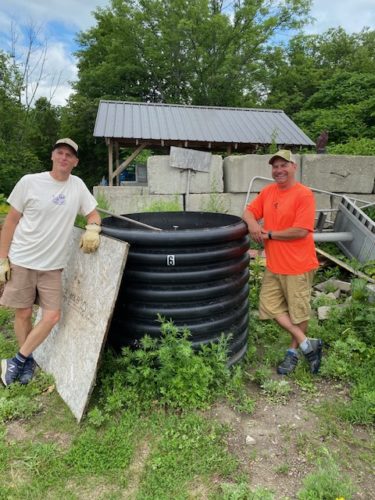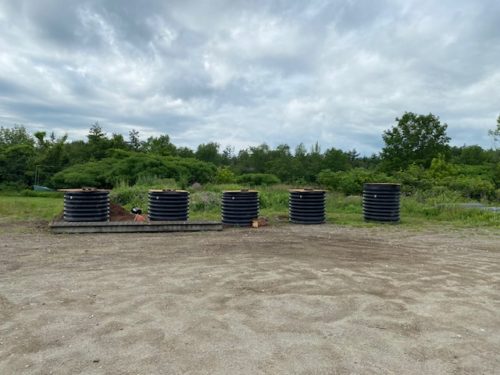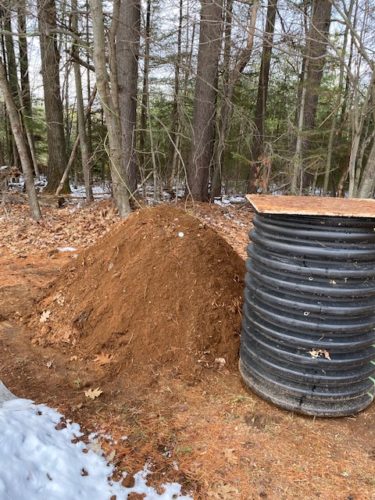by John Culpepper, Katie Culpepper and Jennifer Perry; Compost for Good
Compost for Good has developed a simple, effective and inexpensive food scrap composting system that could revolutionize the small-scale composting world.

Camp Dudley’s Executive Director Matt Storey and Facilities & Compliance Director Jamie Johnson stand beside a neighborhood-scale compost system.
Compost for Good (CfG) — a project of ANCA and AdkAction — helps individuals, organizations, businesses, institutions and communities recognize that there are significant advantages to composting all types of organic material into high value compost through a variety of approaches.
Several years ago, we developed an open-sourced, rotating drum composter capable of processing about 60,000 pounds of food scraps and sawdust or wood chips. There are now at least seven of these units in the U.S., as well as a company in the Netherlands that has taken our design and reworked it for use in northern Europe.
However, we recognize that there is a need for a smaller, simpler, and much less expensive system to compost organics at a neighborhood or organization scale. Therefore, CfG has developed a DIY “neighborhood-scale” composting system capable of composting well over 10,000 pounds of food scraps (including meat and dairy) and wood chips per year. This simple system consists of a 3- or 4-foot diameter, 4-foot long polyethylene highway culvert with a plywood top, compost thermometer and auger. The total cost of the unit comes to approximately $700.
CfG believes this system is one way to bring composting to a much wider audience at an affordable price — and to help keep plant nutrients and dollars in the local economy. We also believe that this is a system that can be scaled for individuals who want to go into commercial-scale composting by operating multiple smaller units simultaneously with relatively low initial capital investment.
If fed with an appropriate recipe (food scraps, wood chips and or other carbon materials), temperatures inside the composter can reach 150° F, rendering even the most disgusting food scraps into a stable organic material within several days. When operated correctly, these systems don’t attract dogs, vermin or flies, and odors are minimized because of the contained design.
An auger is used to both aerate and mix the material in the drum either manually by hand or with a newly designed auger that fits into a ½ inch portable drill. Actium Resources — a Canadian compost equipment manufacturing company — can ship a 37 ½ inch auger to you for about $65. Actium can be reached at john@actiumcomposting.com
Once the material inside of the drum has stabilized, and the temperature drops to air temperature, the important step of curing can be accomplished by tipping the drum on its side and creating a pile with the contents. To create high quality, biologically robust compost, the maturing pile needs to be kept at about 50% moisture content for an additional month or two.
These systems can be set up in a matter of minutes. The user spends about three minutes per day aerating and mixing the contents inside of the drum, and another 30 minutes to an hour once a full drum needs to be emptied.
It should be noted that highway culverts are typically sold in 20 foot lengths and since each composter is four feet long (or four feet high once you set it up), you may need to find others interested in sharing the cost of a 20 foot culvert. CfG might be able to help you coordinate a group order.
If you are interested in a free schematic or case study with additional details, please reach out to compost@adkaction.org. We would be happy to discuss this exciting opportunity to streamline the composting process or the basics of turning organic waste into valuable compost.
To participate in upcoming Compost for Good Fall 2023 workshops and events, visit ANCA’s event webpage for more information.


Photos courtesy of Compost for Good.
